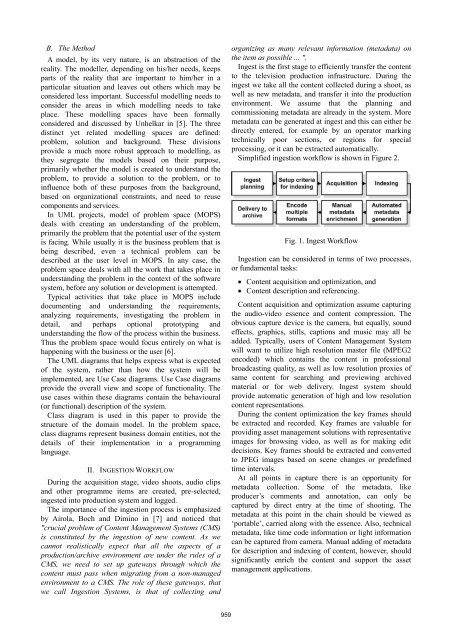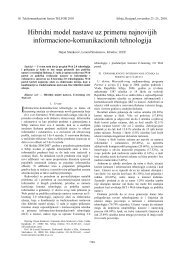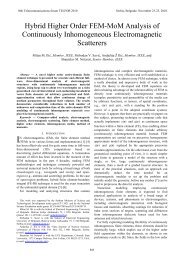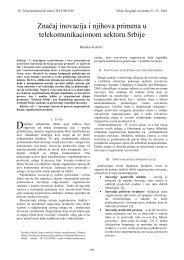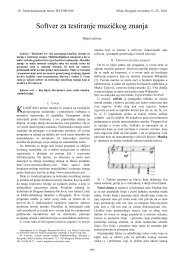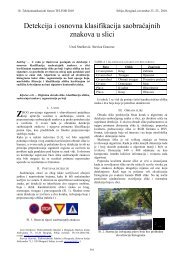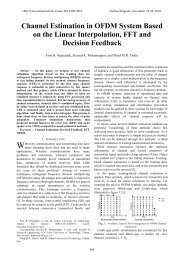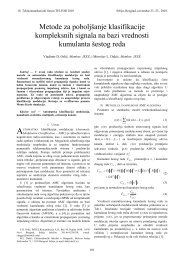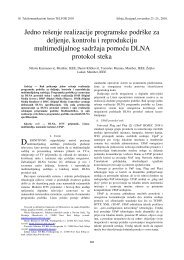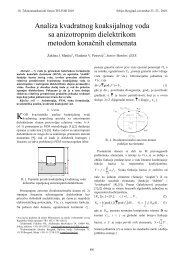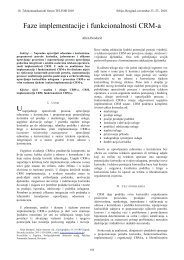TELFOR 2006 - 18. telekomunikacioni forum TELFOR 2010 - Telfor
TELFOR 2006 - 18. telekomunikacioni forum TELFOR 2010 - Telfor
TELFOR 2006 - 18. telekomunikacioni forum TELFOR 2010 - Telfor
You also want an ePaper? Increase the reach of your titles
YUMPU automatically turns print PDFs into web optimized ePapers that Google loves.
B. The Method<br />
A model, by its very nature, is an abstraction of the<br />
reality. The modeller, depending on his/her needs, keeps<br />
parts of the reality that are important to him/her in a<br />
particular situation and leaves out others which may be<br />
considered less important. Successful modelling needs to<br />
consider the areas in which modelling needs to take<br />
place. These modelling spaces have been formally<br />
considered and discussed by Unhelkar in [5]. The three<br />
distinct yet related modelling spaces are defined:<br />
problem, solution and background. These divisions<br />
provide a much more robust approach to modelling, as<br />
they segregate the models based on their purpose,<br />
primarily whether the model is created to understand the<br />
problem, to provide a solution to the problem, or to<br />
influence both of these purposes from the background,<br />
based on organizational constraints, and need to reuse<br />
components and services.<br />
In UML projects, model of problem space (MOPS)<br />
deals with creating an understanding of the problem,<br />
primarily the problem that the potential user of the system<br />
is facing. While usually it is the business problem that is<br />
being described, even a technical problem can be<br />
described at the user level in MOPS. In any case, the<br />
problem space deals with all the work that takes place in<br />
understanding the problem in the context of the software<br />
system, before any solution or development is attempted.<br />
Typical activities that take place in MOPS include<br />
documenting and understanding the requirements,<br />
analyzing requirements, investigating the problem in<br />
detail, and perhaps optional prototyping and<br />
understanding the flow of the process within the business.<br />
Thus the problem space would focus entirely on what is<br />
happening with the business or the user [6].<br />
The UML diagrams that helps express what is expected<br />
of the system, rather than how the system will be<br />
implemented, are Use Case diagrams. Use Case diagrams<br />
provide the overall view and scope of functionality. The<br />
use cases within these diagrams contain the behavioural<br />
(or functional) description of the system.<br />
Class diagram is used in this paper to provide the<br />
structure of the domain model. In the problem space,<br />
class diagrams represent business domain entities, not the<br />
details of their implementation in a programming<br />
language.<br />
II. INGESTION WORKFLOW<br />
During the acquisition stage, video shoots, audio clips<br />
and other programme items are created, pre-selected,<br />
ingested into production system and logged.<br />
The importance of the ingestion process is emphasized<br />
by Airola, Boch and Dimino in [7] and noticed that<br />
"crucial problem of Content Management Systems (CMS)<br />
is constituted by the ingestion of new content. As we<br />
cannot realistically expect that all the aspects of a<br />
production/archive environment are under the rules of a<br />
CMS, we need to set up gateways through which the<br />
content must pass when migrating from a non-managed<br />
environment to a CMS. The role of these gateways, that<br />
we call Ingestion Systems, is that of collecting and<br />
959<br />
organizing as many relevant information (metadata) on<br />
the item as possible ... ".<br />
Ingest is the first stage to efficiently transfer the content<br />
to the television production infrastructure. During the<br />
ingest we take all the content collected during a shoot, as<br />
well as new metadata, and transfer it into the production<br />
environment. We assume that the planning and<br />
commissioning metadata are already in the system. More<br />
metadata can be generated at ingest and this can either be<br />
directly entered, for example by an operator marking<br />
technically poor sections, or regions for special<br />
processing, or it can be extracted automatically.<br />
Simplified ingestion workflow is shown in Figure 2.<br />
Fig. 1. Ingest Workflow<br />
Ingestion can be considered in terms of two processes,<br />
or fundamental tasks:<br />
Content acquisition and optimization, and<br />
Content description and referencing.<br />
Content acquisition and optimization assume capturing<br />
the audio-video essence and content compression. The<br />
obvious capture device is the camera, but equally, sound<br />
effects, graphics, stills, captions and music may all be<br />
added. Typically, users of Content Management System<br />
will want to utilize high resolution master file (MPEG2<br />
encoded) which contains the content in professional<br />
broadcasting quality, as well as low resolution proxies of<br />
same content for searching and previewing archived<br />
material or for web delivery. Ingest system should<br />
provide automatic generation of high and low resolution<br />
content representations.<br />
During the content optimization the key frames should<br />
be extracted and recorded. Key frames are valuable for<br />
providing asset management solutions with representative<br />
images for browsing video, as well as for making edit<br />
decisions. Key frames should be extracted and converted<br />
to JPEG images based on scene changes or predefined<br />
time intervals.<br />
At all points in capture there is an opportunity for<br />
metadata collection. Some of the metadata, like<br />
<br />
captured by direct entry at the time of shooting. The<br />
metadata at this point in the chain should be viewed as<br />
Also, technical<br />
metadata, like time code information or light information<br />
can be captured from camera. Manual adding of metadata<br />
for description and indexing of content, however, should<br />
significantly enrich the content and support the asset<br />
management applications.


